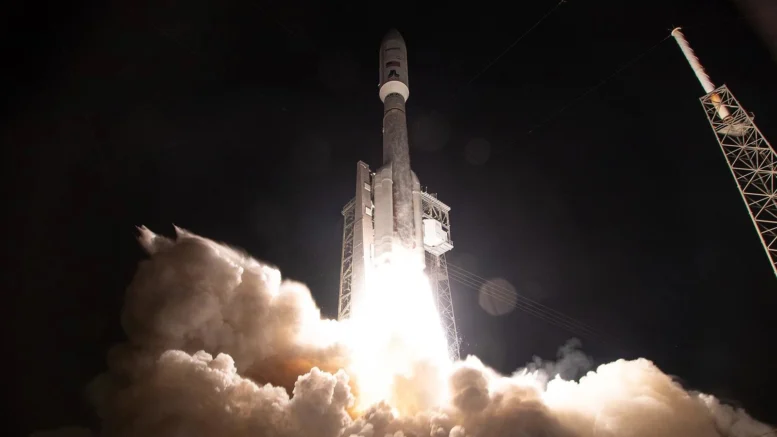Boeing mission controllers confirmed the ViaSat-3 F2 satellite launched successfully after it lifted off from Cape Canaveral Space Force Station at 10:04 p.m. Eastern Time Thursday aboard a United Launch Alliance Atlas V.
Why it matters:
- Boeing designed and manufactured the platform to host Viasat’s flexible payload, pairing Boeing’s proven all‑electric propulsion with high‑power Spectrolab solar arrays to support sustained, high‑throughput operations.
- The ViaSat-3 F2 satellite is expected to more than double Viasat’s bandwidth capacity, supporting the increasing demand for resilient, global satellite communications from commercial mobility and defense customers.
 |
| An on-orbit render of the ViaSat-3 F2 satellite (Image courtesy of Viasat) |
Launch details: The spacecraft separated from the launch vehicle approximately 3 hours and 32 minutes after launch.
- Following separation, Boeing’s Mission Control Center in El Segundo, California, acquired telemetry, verified command links and began subsystem initialization, the team’s standard playbook for on orbit commissioning.
- The spacecraft will raise to its final slot about 22,000 miles above Earth’s surface, complete deployments and in-orbit testing.
- Boeing’s 702MP+ combines all electric propulsion with high power Spectrolab solar arrays to sustain the payload’s capacity over the satellite’s life.
The big picture: Delivering the second of three satellites shows repeatable quality, schedule discipline and mission assurance from factory to flight.
- “Our collaboration with Viasat focuses on enabling their impactful mission to connect everyone. We all know how important reliable high-speed connectivity is to our daily lives,” said Michelle Parker, vice president, Boeing Space Mission Systems. “Delivering the second ViaSat‑3 satellite demonstrates the strength of our partnership and disciplined mission assurance from design to factory to flight.”
Dive deeper
- The Viasat-designed communications payload is built to deliver over 1 terabit per second of total network capacity, the most capacity ever deployed on a single satellite. It can dynamically move beams to shifting demand across land, air, and sea.
- “The ViaSat‑3 ultra-high-capacity satellites are designed to deliver extensive benefits to our customers, including enhanced network efficiency, performance, coverage, and flexibility,” said David Abrahamian, vice president, Space Systems, Viasat. “The successful launch of ViaSat-3 F2 is a milestone in our satellite roadmap and our close collaboration with Boeing is essential to achieving these goals.”
What’s next
- Near term: Mission operations will continue subsystem initialization, followed by orbit raising as the satellite continues its journey to its final orbital slot above North and South America.
- After arrival in geostationary orbit, teams will complete in orbit testing to validate performance before handover to Viasat.
- Boeing teams in the company’s El Segundo satellite factory continue final integration and testing activities on the remaining ViaSat 3 spacecraft to expand Viasat’s global capacity and flexibility.
Source: Boeing in Space










Be the first to comment on "Boeing-built ViaSat-3 F2 launches to space"